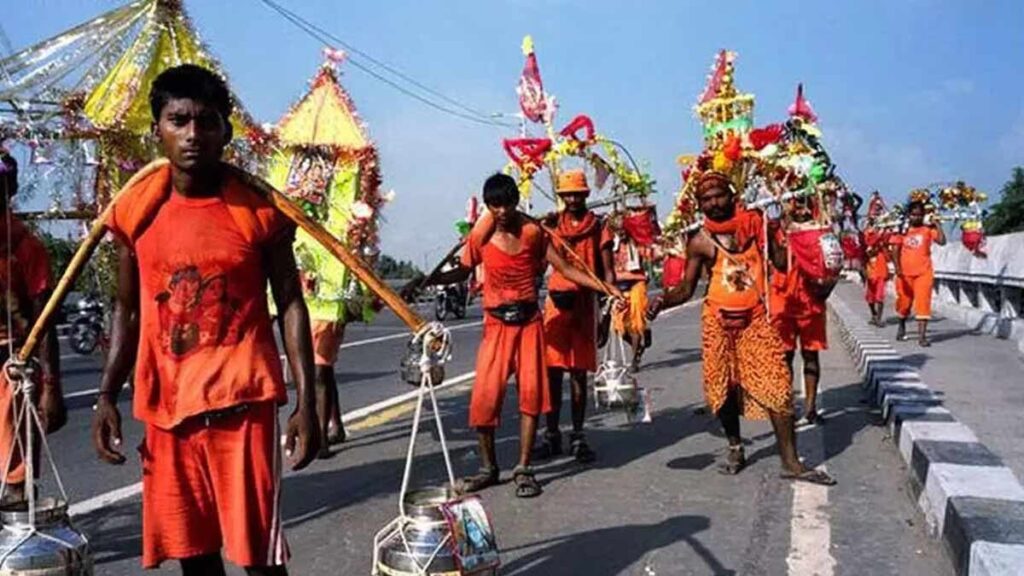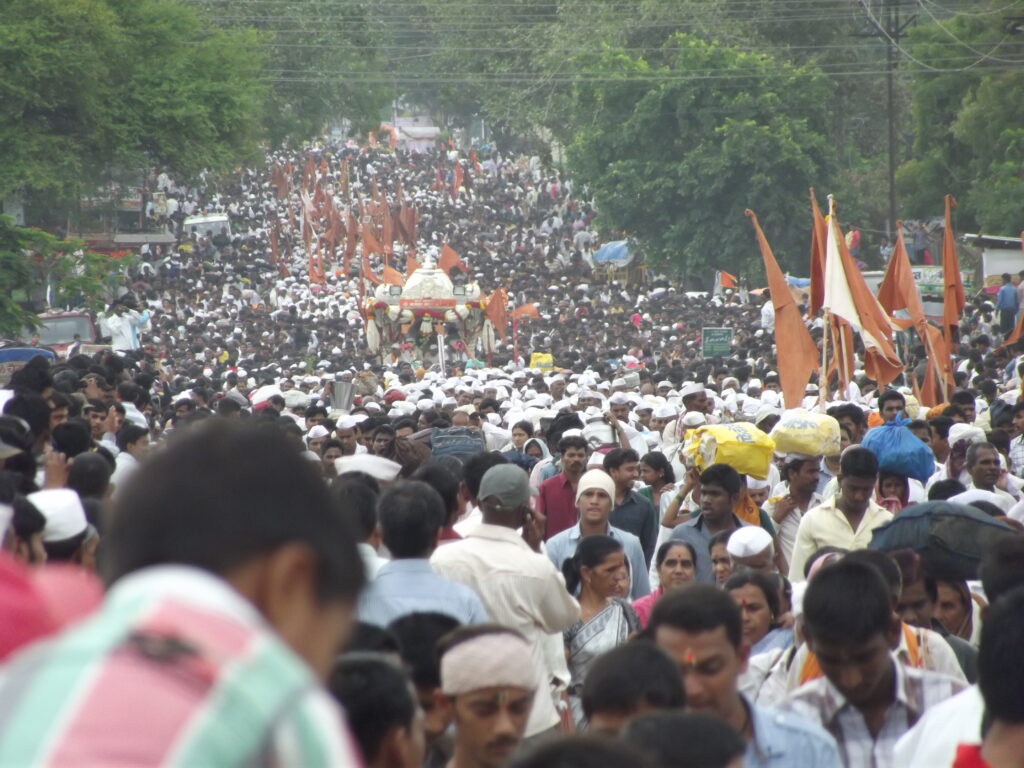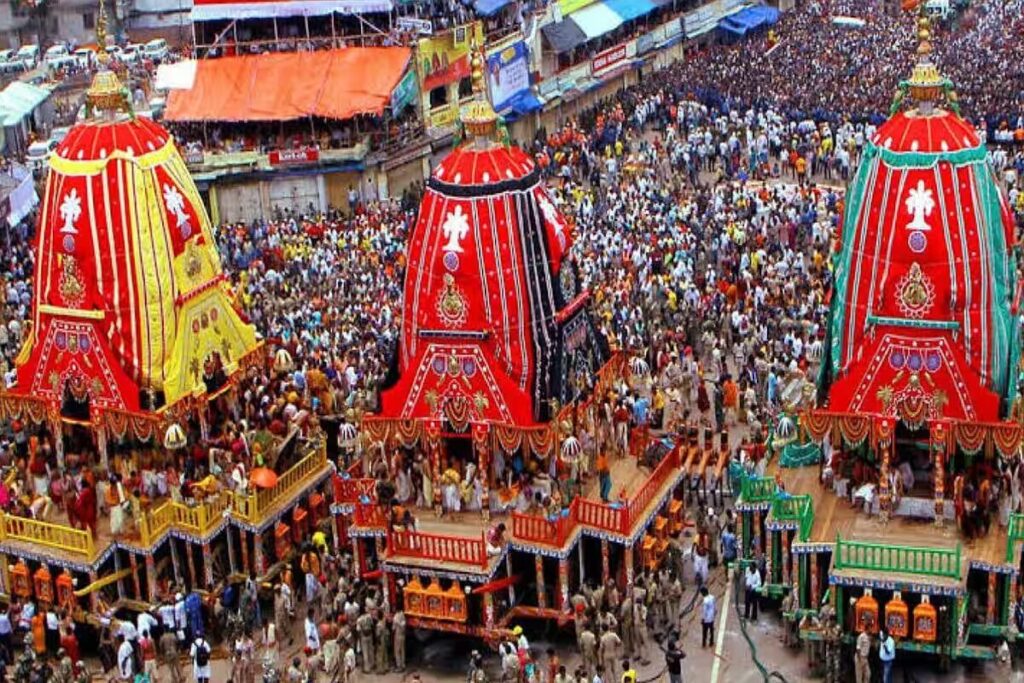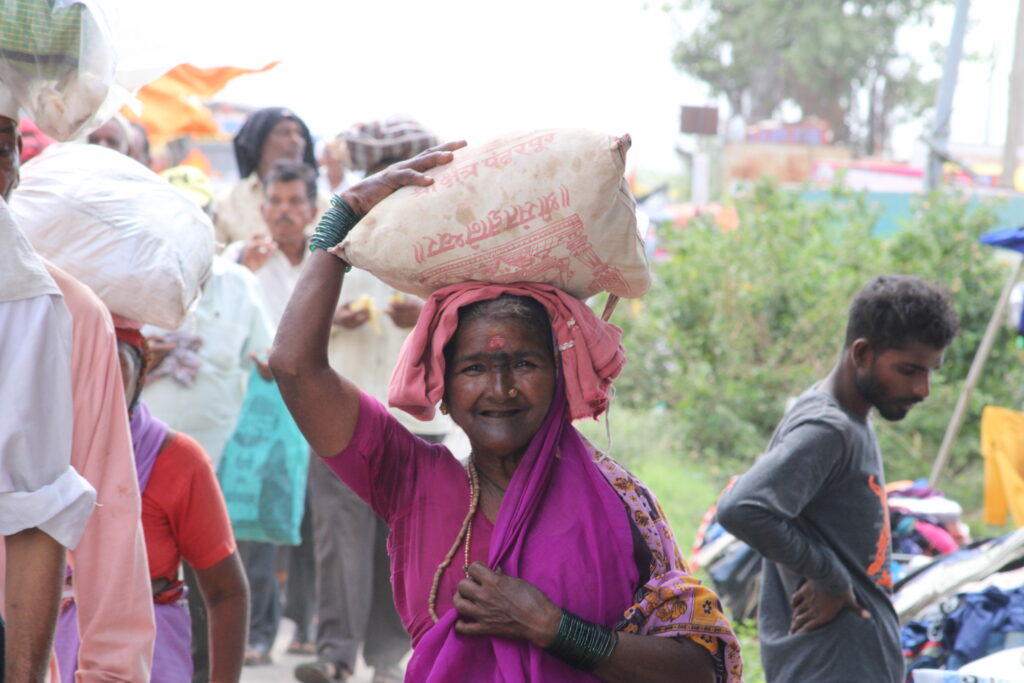As Shravan month starts; and the earth becomes covered by the carpet of green grass; we see thousands of Shiva devotees carrying water pots on their shoulder. The water pots are tied to two ends of a stick, and the pilgrims carry this stick on their shoulder. These Pilgrims; called as Kanwariya; are carrying holy water from rivers, to be bestowed upon Shiva. At most places, the water is fetched from Ganga. But in places farther from Ganga, devotees fetch water from other nearby rivers.

The devotees relate this Kanwar Yatra to the churning of the ocean in Satyuga. When Halahal appeared from the ocean, everyone was afraid to even touch it. At that time, Shiva voluntarily drank the poison to save the world. But, after inhaling it, he started suffering from the negative energy of the poison. In Treta Yuga, Shiva’s devout follower Ravana brought holy water of Ganga by using kanwar and poured it on Shiva’s temple in Puramahadev. Thus releasing Shiva from the negative energy of the poison. To this day, the devotees follow this procedure that was initiated by Ravana in Treta Yuga.
The Kanwariyas carrying water on their shoulders is not the only instance of devotees walking to meet their deity.
In the month of Ashadha, lakhs of devotees in Maharashtra walk to Pandharpur from different parts of the state. The pilgrimage, known as Wari, is closely associated with the Bhakti tradition of medieval era. The waris initiate from places associated with different saints, and all these waris submerge at Pandharpur on the day of Devshayani Ekadashi or Ashadhi Ekadashi. The devotees in Wari carry the Paduka (ancient form of footwear) of these saints in a palaquin. The two most important of these Waris initiate from Dehu and Alandi (both in Pune district).

There are two theories regarding the beginning of the Wari. According to one theory, Vitthalpant, the father of the saint Dnyaneshwar, began the wari to visit Pandharpur in the months of Ashadha and Kartik. The tradition of performing a Wari is generally regarded to have existed for more than 800 years. Another theory credits Dnyaneshwar and Tukaram to have started the pilgrimage. They used to take a journey to Pandharpur by foot for 15 days, reaching Pandharpur’s Vithoba Temple on Shayani Ekadashi. The tradition of carrying the paduka of the saints was started by the Tukaram’s youngest son, Narayan Maharaj, in 1685.
Changes were brought to the pilgrimage in the 1820s by Tukaram’s descendants and a devotee of Dnyaneshwar named Haibatravbaba Arphalkar, who was a courtier of the Scindias of Gwalior. Haibatravbaba is credited with the organization of the wari in use today. This involved carrying the paduka in a palkhi, having horses involved in the procession, and organizing the devotees or varkaris in Dindis (Dindi stands for a specific group of varkaris). In today’s age, more than 10 lakh varkaris walk for 15 days, to reach Pandharpur. It is one of the largest religious gatherings in India. The Wari has recently been nominated for UNESCO World Heritage Tag from Government of Maharashtra.
If we move from the western India to Eastern India, we can see another grand celebration of pilgrimage on foot. The Jagannatha Rath Yatra in Puri of Odisha is one of the most celebrated chariot ride of deity. Ratha Yatra, or chariot festival, is any public procession in a chariot. They are held annually during festivals in India, Nepal and Sri Lanka. Ratha Yatra processions have been historically common in Vishnu-related (Jagannath, Rama, Krishna) traditions in Hinduism across India, in Shiva-related traditions, saints and goddesses in Nepal, with Tirthankaras in Jainism, as well as tribal folk religions found in the eastern states of India. Notable Ratha Yatras in India include the Ratha Yatra of Puri, the Dhamrai Ratha Yatra in Bangladesh and the Ratha Yatra of Mahesh. Hindu communities outside India, such as in Singapore, celebrate Ratha Yatra such as those associated with Jagannath, Krishna, Shiva and Mariamman.

The Ratha Yatra of Puri is considered the oldest and largest Hindu chariot festival. It is celebrated annually, on the bright half of the lunar month of Ashadh (June–July). The festival is associated with the deity Jagannath (a form of Vishnu or Krishna). During the festival, three deities (Jagannath, his brother Balabhadra and sister Subhadra) are drawn by a multitude of devotees in three massive, wooden chariots on bada danda (the grand avenue) to Gundicha Temple whereby they reside there for a week and then return to the Jagnannath temple. This return trip is referred to as the Bahuda Yatra. Records of the festival have been noted by European travelers since the 13th century, with the most prominent and vivid descriptions noted in the 17th century.
If we take a look towards the southern part of the country, we will notice hundreds of devotees walking from Tirupati to Tirumala, to meet the Venkateshwara swamy at the Tirumala hills. Some prefer the 7.8 km long route that starts at Alipiri, and some prefer the 2.5 km long route starting at Srivarimettu. But either way, the process involves walking on the hills to visit the Vaishnavite shrine on the top of the hill. The routes have been in use for centuries, and was the only way to visit the shrine, until roads were built for vehicles.
Similarly, the pilgrimage to Ayyappa Swamy temple in Sabarimala involves crossing a distance of 61 km on foot. The sacred route of this pilgrimage starts at Erumely and reaches Sabarimala crossing multiple rivers and hills. It is said that Lord Ayyappa had taken the same route, and by walking on the same path, one is getting closer to Ayyappa. One also has to do a 41 days Vratam before doing this pilgrimage. Some also take shorter routes like one starting from Vaniperiyar (around 13 km) or the one starting from Chalakayam (around 8 km).
In earlier era, walking was the only option to do pilgrimage. Of course, there were means like horses or horse carts for those who could afford. But for others, one had to walk from one place to other. The story of Ramayana starts with a young boy named Shravana carrying his blind parents on a pilgrimage. He had made a special Kanwar for this purpose, just like the Kanwariyas use to carry water for Kanwar Yatra. We also hear about the Digvijay Yatra done by Adi Shankaracharya, where he travelled from Himalaya to Kanyakumari and Bengal to Gujarat on foot. This was a quest to propagate his philosophy of Vedic Hinduism, defeating his opponents in theological debates.
Even today, one has to walk long distances to reach places like Kedarnath, Amarnath, Manasa Sarovar, Gangotri, Yamunotri. This is because of the adverse weather conditions and geographical limitations. But why would someone prefer to walk where motorable roads are available? What inspires them to walk such long distance? The Kanwarias walk carrying water pots on their shoulder; the Warkaris walk with a Tulsi on head; Jagannatha devotees drag the heavy wooden chariot with their hands; Ayyappa devotees have the 61 km walk pilgrimage after doing a very strict Vratam for over a month. What could be the driving factor for such hardships?
I had been part of Alandi to Pandharpur wari in 2022. Everyone in the Wari would be walking in scorching heat with a smile on face. They would get tired, they would feel pain in legs, they would need to take multiple stops during 4-5 hour walk in a day. But they would still be happy and satisfied. They would still have a smile on their face, the smile that appears out of mental satisfaction.

I interacted with many devotees on my way. I asked them what drives you to be part of this pilgrimage. I was expecting answers like “I want something from God, so I am offering my devotion”, or something like “My dad used to walk every year. If I don’t continue the tradition, something bad may happen to me”. Basically I expected hunger or fear to be reasons behind this. But instead the answers I got were very different. One old man said “I walk because I can. I want to meet Panduranga (another name of deity Vitthala). So I walk. The day I won’t be able to walk, I will stop coming to Wari.” Another old lady said “I like to walk with all those people. I like to be part of the Bhakti. So I walk”. I asked them “why are you taking so much effort at this old age? What if something happens to you?” Their simple answer was “He has given us life. He has the right to take it away anytime. I would be lucky if I die in wari. That way, I will be close to him and I will be happy when I die.”
I met one award winning photographer in the wari. I asked him “What do you capture in wari? The Palanquin carrying the paduka, the saffron flags, pot of basil on heads of devotees or the people walking?” He asked me to move beyond things and look at emotions. He said “I capture pure love. The love these devotees have for their deity. The love that can be seen in their smiles. And the love I can never capture on face of any trained model.” Another person I met was a multibillionaire. He owns a film production company and also few other large scale industries. He definitely was a very busy person. I asked him how he gets time for Wari and why would he spend 15 days here, leaving his business behind. He mentioned that he leaves his work phone at office when he comes to wari. And when asked what he gets, he mentioned “I always leave in this impression that I am a bigshot person. I realise that a sense of pride and arrogance comes to me. But when I first time came to wari for just a day, I saw how happy these people are. They don’t have much money or resources, but they are happy just to be doing something for Vitthala. I felt a very positive energy that time. Now I come every year and absorb all this positive energy. They keep me inspired and also keep me on ground while I am working.”
I also interacted with some devotees walking from Tirupati to Tirumala. Some were doing it just for fun, some were walking for a thrill of hiking. But many devotees expressed that this is one way to present their devotion to Balaji. For some devotees, this was also a token of thanks for the deity. Similar feelings were expressed by devotees walking in Puri Rathayatra.
When I think about the reasons behind the pilgrimage on foot, I realise that there is same answer to another question. Why do we fast when we have abundant food? Because real devotion is in giving up and giving away. When one is walking to meet deity, he or she is giving away the comfort of a motor vehicle. When one fasts for deity, he or she is giving away the comfort of having food. Even if it is momentary, it still is giving you a positive energy. The energy that comes from the realisation that I have stepped out of my comfort zone for my deity. Meeting deity is a goal worthy of stepping out of the comfort zone.
And this also provides us another important understanding. If you want to achieve your goals, may it be in work or studies, you have to be ready to step out of your comfort box. Otherwise, you will be stuck in the same cycle. Only when you step out of the comfort zone, is when you realise there is more to life. You face some new challenges and learn how to overcome them. And you get new energy to proceed towards your goal.
